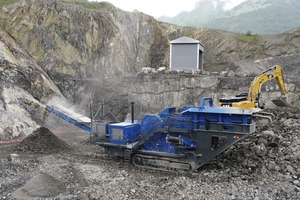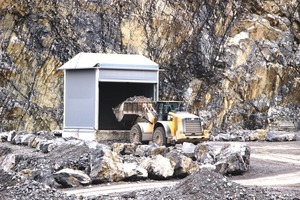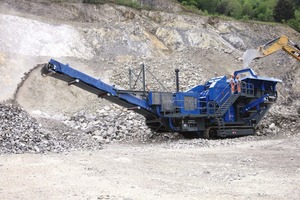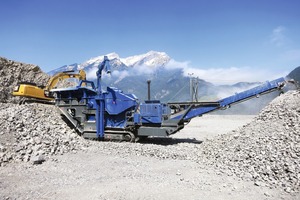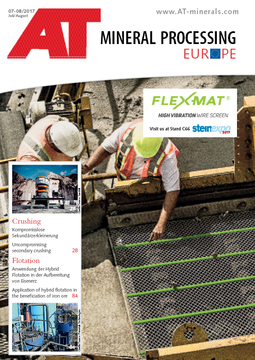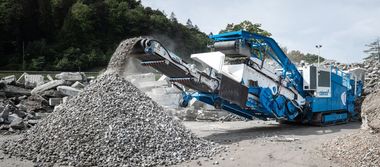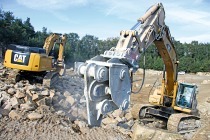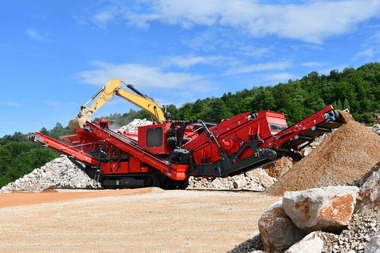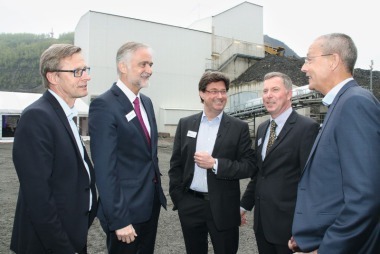Quarrying high-grade rock
A GIPOBAC B 1410 FDR track-mobile jaw crusher is operated as the main machine in Rüti Quarry. The data for the extraction site show an extractable volume of 3.4 mill. m3 rock. The annual amount adds up to around 100 000 m3. The entire extraction operation is divided into five stages. The quarry is opened up by an underground belt conveyor tunnel and a 100-m-high vertical shaft. After the end of extraction, recultivation with secondary utilization is to take place; this foresees some planted rock walls, pioneer areas, woods and meadow land as well as backfill with existing overburden.
Development of the quarry since 2006
Rüti Quarry was opened up ten years ago as a replacement for the quarry in Rotzloch shut down in 2008. With this quarry, supply of the Stansstad plant with hard rock material can be assured for the next three decades. The extraction concept is based on localized rock blasting and comminution in a track-mobile GIPOBAC B 1410 jaw crusher. For the transport into the production facilities in the Rotzloch vicinity, a vertical shaft and a tunnel with a length of 912 m with belt conveyor have been built. The shaft is filled continuously with pre-crushed material by a wheel loader. At the bottom end of the shaft, the material is fed onto the belt conveyor in a cavern.
Since 2013, a new chippings plant for feed material 0-22 mm has been in operation in Rotzloch. This comprises a vertical crusher, elliptical screen, sand trap and cyclone system. The throughput rates at the crushing station amount to 70 t/h and for loading onto lorries or ships 400 t/h. The crusher designed to be compact on account of the restricted space available was commissioned by Frei Fördertechnik AG as general contractor. The complete steel construction and the silo batteries have been erected on foundation plates.
GIPO’s largest crusher type in action
From the outset, Rüti Quarry was operated with a GIPO crusher. In eight years, this type of crusher, the 1195, has delivered around 10 000 working hours. As Patrick Lussi, Department Manager for hard rock products and inert materials landfill at the Stansstad facility explained, it was, however, clear that with the increased rock extraction at Rüti Quarry this type of crusher had reached its limit in terms of capacity.
The evaluation of a replacement machine by the quarry operator foresaw a considerable increase in the crushing capacity from 200 to 300 t/h. In addition came the criterion of a larger rock feed, to reduce the operating hours of the hydraulic hammer at the excavator.
Configuration to customer specifications
Decision criteria also included the incorporation of the operator’s specific preferences and the nearness to the supplier. One key factor was that the GIPO crusher is manufactured individually to meet customers’ specific requirements in Seedorf, Uri. In the case of the GIPOBAC for the Rüti Quarry, these requirements included lowering the feed height of the hopper, a filling level monitor for the feed with automatic shut-off, lengthening of the discharge belt, catwalks and platforms at the sides for safe access and maintenance as well as a material cushion at the crusher discharge onto the belt conveyor and a hood over the entire length of the belt conveyor, and a hinged cover for the crusher inlet. In addition, the crusher is fitted with a hydraulic hammer on the feed hopper to enable immediate intervention if any rock gets stuck.
A more powerful design of the drive unit was specified, as Lussi went on to explain. The idea behind this was that only half of the 540 HP power of the selected diesel hydraulic drive CAT with 540 HP is actually utilized, enabling a significant fuel reduction and a longer lifetime to be achieved. Great importance is attached to safety in operation during crushing of the rock, which thanks to remote control of the crusher can be performed by just two operatives. Initial experience of the crusher in operation since mid-May has been very good according to Lussi. He mentions especially the high production rate per working day of up to 2 700 t from the start, which works out at an average of 2 500 t/d, eliminating the need for overtime hours previously necessary in peak times.
Machine components
The GIPOBAC B 1410 FDR track-mobile jaw crusher is a single-toggle jaw crusher, which is very rugged and suitable for handling hard rock. It has a feed opening measuring 1330 x 1000 mm and features a separate double-deck scalping screen with a screen length of 3000 mm. With this, an increase in the quality of the finished product is achieved thanks to the removal of fines, platy particles and any impurities. Moreover, with this pre-screening, the crushing rate is increased and wear reduced.
Installed in the power pack is a Caterpillar diesel engine stage IIIB of the type C15. Like all other drives, the crusher drive is based on the tried and tested fully hydraulic drive concept. This permits start-up of the crusher with a full crusher mouth and infinite regulation of the speed with constant crushing force. The automatic filling level control ensures a high crushing rate. Like in other GIPO crushers, the material flow concept avoids narrowing of the materials stream, with the system widths of the conveying elements “opening” up in the direction of the material flow.
Like the other types of machine from this manufacturer, the new GIPO machine impresses generally with high reliability, high processing rate, as well as its rugged and compact design, high-quality components, maintenance-friendly design, easy operation and proven durability. For reasons of environmental protection, these crushers have already been equipped for several years now with diesel engines complying with the latest exhaust gas standards.

